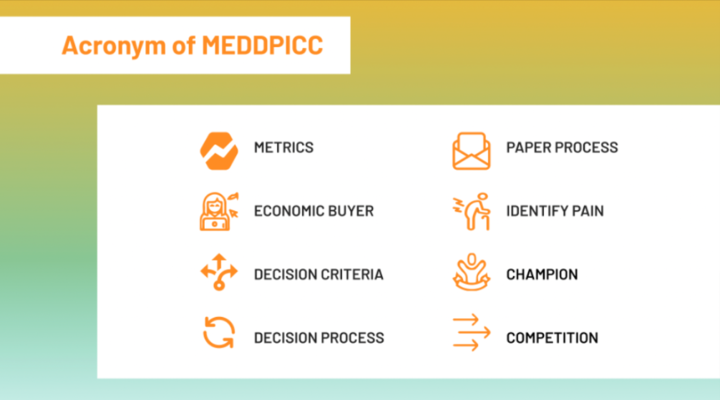The sales process is a critical component of any successful sales strategy. From prospecting to close, each step in the sales process is crucial for driving revenue growth and building long-term customer relationships. One proven approach to the sales process is the MEDDPICC process, which helps sales teams identify and prioritize high-value opportunities and close deals more effectively.
In this article, we’ll explore the ultimate guide to a successful sales process, including the key steps involved in the MEDDPICC process, and share tips and best practices for each stage of the sales process. Whether you’re a seasoned sales professional or just starting out, this guide will provide you with the tools and strategies you need to succeed in sales and drive success for your business.
What is the Sales Process?
A sales process refers to the systematic series of steps that a sales team follows in order to move a potential customer from the initial point of contact to closing a deal or sale. With a defined sales process, you avoid losing leads your marketing team has generated, nurtured, and provided to your sales team.
Read also: Migrating From Migraines to Miracles with These 7 Simple Strategies
Sales Process Steps
A typical sales process might involve the following steps:
Prospecting: The first step in the sales process is prospecting. There are several ways to identify potential customers such as referrals, cold calling, social media, trade shows, and networking events.
To execute prospecting effectively, you need to create a target customer profile that outlines the characteristics of your ideal customer. This will help you to focus your efforts on the right audience and avoid wasting time on unqualified leads.
Qualifying: Once you have identified potential customers, the next step is to qualify them. This step involves evaluating whether the prospect has the budget, authority, need, and timeline to buy your product or service. Qualifying helps you to focus your efforts on prospects who are most likely to convert into paying customers.
To qualify a prospect effectively, you need to ask the right questions that help you to identify their pain points, challenges, and goals.
Needs Assessment: Once you have qualified a prospect, the next step is to assess their needs. This step involves understanding the prospect’s pain points, challenges, and goals in detail.
To assess a prospect’s needs effectively, you need to ask open-ended questions that allow the prospect to share their thoughts and feelings. You should also actively listen to their responses and take notes so that you can address their concerns later in the sales process.
Presentation: Once you have assessed the prospect’s needs, the next step is to present your product or service. This step involves demonstrating how your product or service can solve their problems and help them achieve their goals. Your presentation should be tailored to the prospect’s specific needs and goals.
To present your product or service effectively, you must highlight its features and benefits.
Handling Objections: It is rare to encounter a prospect who will agree to buy your product or service without any objections. Therefore, the next step in the sales process is handling objections. This step involves addressing any concerns or objections that the prospect may have about your product or service.
To handle objections effectively, you need to empathize with the prospect and acknowledge their concerns. You should then provide a solution that addresses their specific concerns. For example, if the prospect is concerned about the price, you can offer a payment plan or a discount.
Closing: The final step in the sales process is closing. This step involves getting the prospect to commit to buying your product or service. Closing requires a strong call to action that motivates the prospect to take action.
To close effectively, you must create a sense of urgency by highlighting the benefits of buying now. You should also provide a clear path to purchase and address any last-minute objections the prospect may have.
How to Create a Successful Sales Process for Your Company
The sales process is a multi-step process that requires careful planning and execution. Now you’re familiar with the stages of the sales process, it’s time to create one for your company. Here are some steps to create a successful sales process.
Define your target customer: Start by identifying the specific group of people who would be most interested in your product or service.
Set sales goals: Determine your sales targets and define the key performance indicators (KPIs) that will measure success.
Develop a sales strategy: Based on your target customer and sales goals, develop a sales strategy that includes tactics for prospecting, qualifying leads, presenting your product or service, handling objections, and closing deals.
Monitor and adjust: Regularly review your sales process and KPIs to identify areas for improvement. Use data like customer feedback, sales data, and performance metrics to make decisions about how to adjust your sales process to better meet the needs of your customers and achieve your sales goals.
Overall, building a successful sales process requires a deep understanding of your customers and a commitment to delivering value throughout the sales journey. By investing in the right strategies, tactics, and training, you can create a sales process that drives revenue growth and builds long-term customer relationships.
(Note: Is this article not meeting your expectations? Do you have knowledge or insights to share? Unlock new opportunities and expand your reach by joining our authors team. Click Registration to join us and share your expertise with our readers.)
